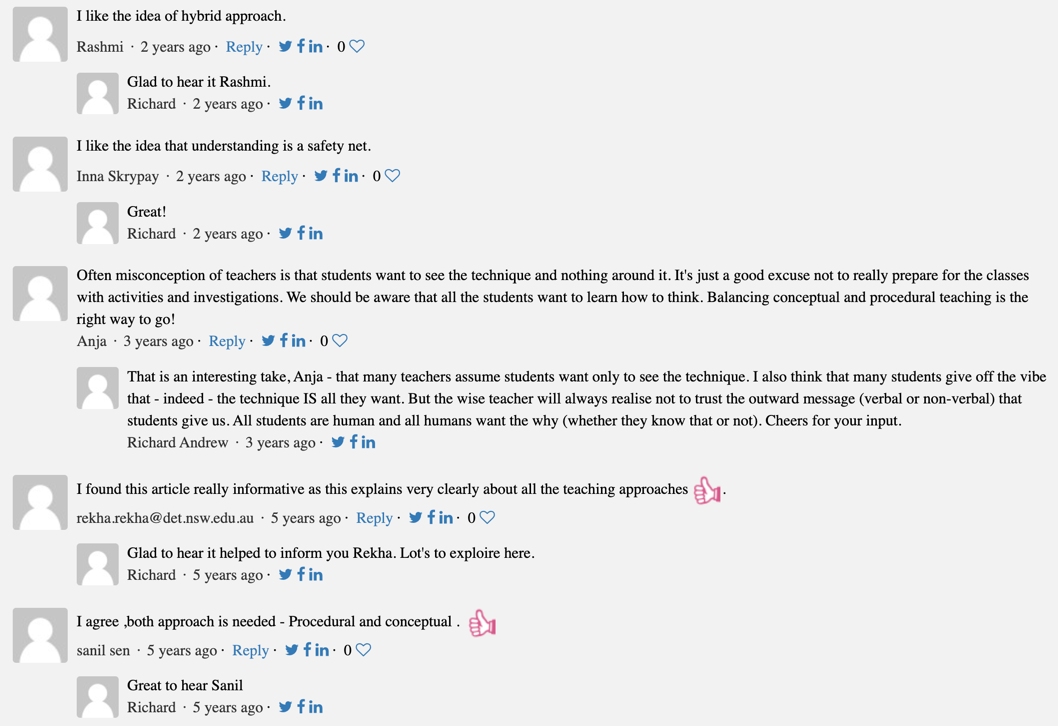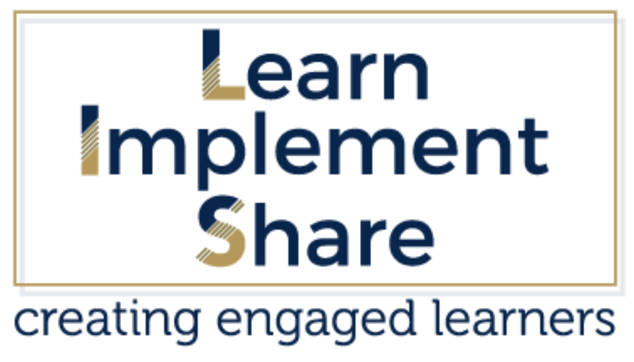Procedural vs Conceptual Knowledge - A Hybrid Approach to Teaching Mathematics.
Nine Keys To The Hybrid Conceptual-Procedural Approach
|
There has been a long-running debate about whether a conceptual approach is better for teaching mathematics or whether teaching procedurally is superior. In the US especially, the debate divides mathematics educators into two opposing camps - the proceduralists vs the conceptualists. The arguments from each camp have tended to be mutually exclusive. In his article 'Is it true some people can't do math?' Daniel Willingham states:
'At the extremes, progressives claim that traditionalists would be happy for students to execute procedures without understanding what they are doing, and traditionalists claim that progressives care only that students understand concepts and are unconcerned about whether they can actually solve math problems.' I'm proposing, in this article, that this long-running ‘Procedural vs Conceptual’ debate - i.e. that either one or the other is superior - is flawed. Below are nine keys which shed some light on why we can no longer argue that the ideal approach to mathematics education is either procedural or conceptual, that a hybrid approach is required and what that hybrid approach looks like. Several of the nine keys require expanding. Links to the expansions are provided throughout (with a link at the bottom of each expansion returning you to your exit point on this page.) |
Key One
Both procedural and conceptual approaches to the teaching of mathematics contain necessary prerequisites in order for students to be successful with high school mathematics.
Both procedural and conceptual approaches to the teaching of mathematics contain necessary prerequisites in order for students to be successful with high school mathematics.
Key Two
Routines and Procedures
The necessary prerequisite to learning mathematics that is best provided by a quality procedural approach is the explicit teaching of routines and procedures.
Key Three
Conceptual Understanding
The necessary prerequisite to learning mathematics that is best provided by a quality conceptual approach is conceptual understanding in students (students understanding what it is they are working on in class).
Key #3 is unpacked here
Key #3 is unpacked here
We need to reference ‘constructivism’
Allow me to offer a few ‘feet-on-the-ground’ thoughts on constructivism.
My view is that constructivism is a description of the process by which most of us learn anything of real importance. By ‘real importance’, I refer to the task of learning something because we have a genuine need for it and so we initiate a self-directed, learning-by-doing path to master that skill. Examples? Learning to sew, learning to build a shed (or house), learning to master the art of gardening, learning to paint portraits and so on.
Constructivism, therefore, could be seen to be 'learning via self-initiated, practical exploration'. I would say ‘Montessori’ is based on the principles of constructivism.
My view is that constructivism is a description of the process by which most of us learn anything of real importance. By ‘real importance’, I refer to the task of learning something because we have a genuine need for it and so we initiate a self-directed, learning-by-doing path to master that skill. Examples? Learning to sew, learning to build a shed (or house), learning to master the art of gardening, learning to paint portraits and so on.
Constructivism, therefore, could be seen to be 'learning via self-initiated, practical exploration'. I would say ‘Montessori’ is based on the principles of constructivism.
Why are we talking about constructivism?
I'm referencing constructivism because maths educators often confuse ‘a conceptual approach’ with ‘a constructivist approach’. However, in this article when using the term 'conceptual' I am not referring to constructivism. Rather, I'm referring to something more prescriptive, more explicit, more directed.
Click to read: Constructivism unpacked
Click to read: Constructivism unpacked
Key Four
The procedural vs conceptual debate is flawed because the common belief (that the two approaches are mutually exclusive) is a misconception. A hybrid approach is possible which includes the essential prerequisites from both approaches - the explicit teaching of procedures AND the ‘enabling of students to understand what it is they are working on', ideally from the time they commence working on it.
Key #4 is unpacked here
The procedural vs conceptual debate is flawed because the common belief (that the two approaches are mutually exclusive) is a misconception. A hybrid approach is possible which includes the essential prerequisites from both approaches - the explicit teaching of procedures AND the ‘enabling of students to understand what it is they are working on', ideally from the time they commence working on it.
Key #4 is unpacked here
Authentic engagement of students
Key Five
We need to talk about student engagement. Why? Because unless students are authentically engaged in what they are working on - i.e. immersed in activities, understanding the related mathematics and owning their learning - then their ability to learn is severely handicapped. Authentic student engagement is a fundamental pre-requisite for the learning of mathematics.
Interestingly, despite being fundamental to the learning of mathematics, the authentic engagement of students rarely features in procedural vs conceptual debates.
Given that student engagement is key to the learning of mathematics it needs to be said that a well-structured conceptual approach is superior when it comes to authentically engaging students - i.e. immersing them in activities, having them understand what it is they are working on and owning their learning.
Key #5 is unpacked here
We need to talk about student engagement. Why? Because unless students are authentically engaged in what they are working on - i.e. immersed in activities, understanding the related mathematics and owning their learning - then their ability to learn is severely handicapped. Authentic student engagement is a fundamental pre-requisite for the learning of mathematics.
Interestingly, despite being fundamental to the learning of mathematics, the authentic engagement of students rarely features in procedural vs conceptual debates.
Given that student engagement is key to the learning of mathematics it needs to be said that a well-structured conceptual approach is superior when it comes to authentically engaging students - i.e. immersing them in activities, having them understand what it is they are working on and owning their learning.
Key #5 is unpacked here
The hybrid approach
Key Six
The hybrid conceptual approach is a highly-structured, mostly student-centred and conceptually-based but also incorporates the explicit teaching of procedures.
There are two important principles required for the hybrid conceptual approach to be successful:
Key #6 is unpacked here
The hybrid conceptual approach is a highly-structured, mostly student-centred and conceptually-based but also incorporates the explicit teaching of procedures.
There are two important principles required for the hybrid conceptual approach to be successful:
- It must be (predominantly) student-centred. Yes, it is highly structured. Yes, the teacher still has control over the direction of the learning. But it cannot be driven by the sort of teacher-centredness that drives a traditional procedural approach.
- The first aim of any teacher using the hybrid conceptual approach is to have students understand what it is they are doing within an activity. The second aim of the teacher - also important but it must FOLLOW the first - is the teaching of procedures. In other words, the teacher prioritises using an 'understanding first, procedures second' mindset.
Key #6 is unpacked here
A paradigm shift
Key Seven
As has already been suggested, adopting the hybrid conceptual approach requires - for many teachers - a different pedagogy to what they are used to. Although it is easy to administer once sufficient experience has been gained, the transition requires some time and guidance.
Key Eight
The transition requires a paradigm shift in the teachers’ thinking and classroom management. Ideally, teachers making the shift will receive some quality, ongoing professional guidance that requires them to implement a range of well-structured, student-centred, conceptually-based activities.
Key Nine
What is required is some comprehensive guidance for mathematics teachers to help them make a successful transition to a hybrid conceptual approach, preferably using a department-wide, team-based approach.
Keys #7, 8 & 9 are unpacked here
As has already been suggested, adopting the hybrid conceptual approach requires - for many teachers - a different pedagogy to what they are used to. Although it is easy to administer once sufficient experience has been gained, the transition requires some time and guidance.
Key Eight
The transition requires a paradigm shift in the teachers’ thinking and classroom management. Ideally, teachers making the shift will receive some quality, ongoing professional guidance that requires them to implement a range of well-structured, student-centred, conceptually-based activities.
Key Nine
What is required is some comprehensive guidance for mathematics teachers to help them make a successful transition to a hybrid conceptual approach, preferably using a department-wide, team-based approach.
Keys #7, 8 & 9 are unpacked here
Course Information:
Agency - Empowering Your Mathematics Students: Info Testimonials
Conceptual Coordinate Geometry: Info Testimonials
Conceptual Coordinate Geometry: Info Testimonials
In closing ...
Some final points need mentioning with regard to adopting the hybrid conceptual approach.
A conceptually-based activity is NOT synonymous with ‘lots of hands-on equipment’
A common misconception is that a conceptual approach to teaching mathematics requires hands-on activities with lots of equipment. This is not the case. A hybrid-conceptually-based activity is NOT synonymous with ‘lots of equipment’. This is fortunate because the successful running of equipment-heavy lessons is extremely difficult with most high school students. The example given when unpacking Bullet #3 (the rounding of decimals) did likely involve some equipment but equipment that was handled only by the teacher and perhaps a few students in conjunction with quality, targeted, Socratic questioning.
Note that while the decimal rounding example was relatively easy to articulate it would be almost impossible to explain the hybrid conceptual approach for an entire unit. It would require multiple examples each with several sequenced pages containing explanations, experience-based stories and videos as well as sufficient time for teachers to assimilate the information and implement the approach. The name for such an arrangement of information is ‘comprehensive online course’.
Note that while the decimal rounding example was relatively easy to articulate it would be almost impossible to explain the hybrid conceptual approach for an entire unit. It would require multiple examples each with several sequenced pages containing explanations, experience-based stories and videos as well as sufficient time for teachers to assimilate the information and implement the approach. The name for such an arrangement of information is ‘comprehensive online course’.
A brief summary - combining procedural and conceptual approaches to teaching mathematics
|
Free Tutorial
|
‘Hybrid’ is (mostly) for this article!
The term ‘hybrid’ has been woven into this article as a way of high lighting that the strengths of the procedural approach can be incorporated into a quality conceptual approach. However, in Learn Implement Share courses, we don’t tend to refer to a ‘hybrid’ conceptual approach - we simply call it a quality conceptual approach which, in our view, naturally incorporates the explicit teaching of procedures.
Understanding first, procedures second?For a different angle on the need for a hybrid approach, check out 'Why Students Need To Understand The Concept Before We Teach Them The Procedure.'
Here the hybrid approach is referred to as 'Understanding-first, Procedures-second'. The article is an argument in favour of having students understanding the work we give them to do for the majority of lesson time. |
Over to you
Your input is welcome. We’d love to know what questions you have, what surprised you, what was new for you and what doubts you still hold.
NOTE: Create a Hyvor account before commenting (click LOGIN) -that way you'll be notified of replies and you won't be anonymous.
If you don't create an account, please state your name at the start of your comment. Thanks.
NOTE: Create a Hyvor account before commenting (click LOGIN) -that way you'll be notified of replies and you won't be anonymous.
If you don't create an account, please state your name at the start of your comment. Thanks.






